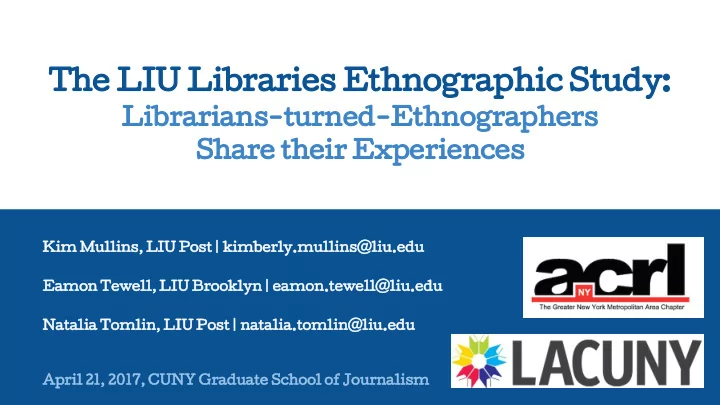

The LIU Libraries Ethnographic Study: Librarians-turned-Ethnographers Share their Experiences Kim Mullins, LIU Post | kimberly.mullins@liu.edu Eamon Tewell, LIU Brooklyn | eamon.tewell@liu.edu Natalia Tomlin, LIU Post | natalia.tomlin@liu.edu April 21, 2017, CUNY Graduate School of Journalism
The Research Team Brooklyn Campus Post Campus Coding Team Katherine Boss Mary Kate Boyd-Byrnes Valeda Dent Valeda Dent Kathleen Burlingame Edward Keane Charles Guarria Thomas Dillman Kimberly Mullins Rachel King Mellissa Hinton Paula Patiño Paula Patiño Kimberly Mullins Bhavya Teja Kolla Susan Thomas Eduardo Rivera Eamon Tewell Ingrid Wang Derek Stadler Natasha Tomlin Gloria Willson Natalia Tomlin
Background and Methods
Ethnographic Research ● The study of a culture to improve one’s understanding of it ● Involves smaller numbers of participants, but in thorough detail ● Qualitative methods, rooted in anthropology: participant observation, reflective diaries, interviews
Our University
Why? ● Examine our local culture of student research habits ● Provide need-based services ● Make ethnography a consistent and ongoing practice
Previous Major Studies ● University of Rochester “Studying Students” Project ● Ethnographic Research in Illinois Academic Libraries (ERIAL) Project ● CUNY Undergraduate Scholarly Habits Ethnography Project
Our Study’s Design SURVEY OBSERVATIONS INTERVIEWS
Our Study’s Timeline Summer 2012 IRB approval received Fall 2012 Survey distributed Spring 2013 Observations conducted Spring 2013 Interviews conducted Spring 2014 Coding process started Spring 2016 Coding process completed
Survey ● 51 questions on tech use, library use, research and study habits ● Administered Fall 2012 ● 1100+ responses ● Used survey data to create interview questions
Sample Survey Questions “Have you had any library instruction while at Long Island University?” “During the last academic year, how often was the Libraries’ website a basic part of your research process?” “Which of these resources do you use most often?” “Would you use text messaging to get an answer to a reference or research question from the LIU Libraries?”
LIU Post Survey Team
Survey Kick-Off
Survey Demographics
Observations ● 32 hours of unobtrusive observations completed ● Conducted Spring 2013 ● Recorded field notes ● Recorded interpretations
Observation Recording Sheet
Interviews ● Recruited interviewees during the survey stage ● Conducted 30 one-hour semi-structured interviews ● Included “show me” questions ● Videotaped and professionally transcribed audio
Sample Interview Questions “When you get an assignment for a class, what is the very first thing you do?” “Do you seek help from library personnel?” “When you study in the library, do you prefer to be around other students, or have more of your own personal space?”
Interview Demographics
Data Analysis and Findings
Survey Analysis 1. Library staff and graduate student entered data into SPSS 2. Quantitatively analysed closed-ended questions using proprietary survey software 3. Performed content analysis for open-ended questions 4. Graphically depicted major themes to identify areas of focus 5. Themes further analyzed
Survey Analysis
Survey Analysis
Codebook ● Added codes identified during coding process (six versions) ● Resulted in 459 codes at question, unit, and thematic levels
Observation Coding 1. Combined into one document and analyzed for frequency counts 2. Read field notes and coded the text 3. Library staff and graduate student entered data into SPSS 4. Statistical analysis performed
Interview Coding 1. Transcripts coded individually, by pairs and as a team (4 coders) 2. Paired teams and entire team reconciled coding to ensure inter-coder reliability 3. Library staff and graduate student entered data into SPSS 4. Statistical analysis performed
Survey Findings ● Majority were not taking advantage of University iPad program ● 75% received some type of instruction on how to utilize the Library and its resources ● Used Google and the Libraries’ databases equally to complete their work
Observation Findings ● Came and went while studying; left personal items ● Seated in groups but worked individually and “cocooning” ● Space used for both academic and non-academic tasks
Interview Findings ● More likely sought assistance from peers or professors than librarians ● Print resources often favored ● Some research and study habits were mutually informative
Triangulated Findings ● Actively browsed for materials as means of discovery (i.e. shelf browsing, catalog subject headings) ● Began assignments with resources from the open web ● Multitasked using technology
Actions Taken and Lessons Learned
Actions Taken Revised core and library curriculum, performed Instruction syllabus analysis for various departments Space Group study areas, natural light, “Genius Bar” setups Extended hours, website redesign, Skype by Reference appointment App development, dissolved iPad program, added Technology electrical outlets
Actions Taken
Challenges ● Time! Four years from start to finish ● Maintaining continuity in the project ● Sifting through the data; huge number of variables makes it almost impossible to exhaust all possibilities
Advantages ● Gained a more complex understanding of library use that could not come from stats and numbers ● Meaningful data to support requests for resources ● Adds a critical lens to what students say and do AND what we think students say and do ● Framework to build upon for future studies & comparisons
Takeaways ● Estimate the amount of time you need, then double it ● Find motivated team members willing to learn as they go ● Find supporters, such as your dean, director, or teaching faculty ● When possible, invest in professional services and resources (i.e. statistical software, transcription, data entry)
Thanks! Kimberly.Mullins@liu.edu Eamon.Tewell@liu.edu @EamonTewell Natalia.Tomlin@liu.edu
Recommend
More recommend